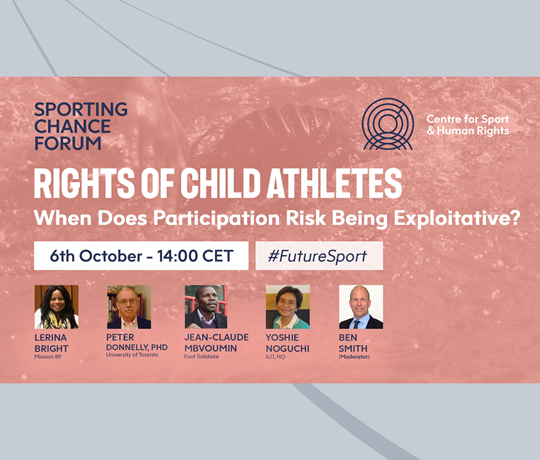Rights of Child Athletes - When does Participation Risk Being Exploitative?
Session Summary
While recognising the many benefits that sport participation brings to children, some former child athletes are questioning the abuse, stress, harassment, intimidation, exploitation and excessive training they encountered at a young age. Such experiences are analogous to those encountered in child labour. Long and excessive hours of training and separation from families is sometimes at the expense of education, and can also take a toll on children and young people’s mental and physical health, time for leisure, and overall wellbeing.
There are demands for a change in the regulations and culture of sport to do more to protect children from situations that have the hallmarks of child labour. If the ‘worker’ status of child athletes were recognised it could provide them with protections related to their health (both physical and mental), education, minimum age in relation to hours worked, abuse, intimidation, commodification, trafficking, unethical contracting, etc. These protections could take the form of regulations or guidelines developed and imposed by sport governing bodies, and / or in the form of legislation and policies of governments.
Sports organisations are grappling with how to better protect child athletes. Some International Sports Federations, National Sports Bodies and a few States have begun to take actions to address some of the concerns in a balanced manner. International treaties, including the UN Convention on the Rights of the Child and International Labour Organization (ILO) Conventions 138 (minimum age) and 182 (worst forms of child labour), provide guidance related to child labour in sport.
In January 2020, the ILO organised a Global Dialogue Forum on Decent Work in the World of Sport. Several of the Points of Consensus of the Forum specifically address the need for special protection for child and young athletes and safeguarding their rights to participate in sport in conditions of freedom, dignity and safety.
Only in last few years has the possibility for change gathered pace, despite concerns having been raised and trends related to child labour in sport explored since the 1960s. The challenge is to nurture talented child athletes and their love of sport without exploiting or abusing them.
Vulnerabilities of children in sports academies additionally links to the trafficking of young persons in sport. Mission 89 is developing a safeguarding toolkit for academies and calls for greater attention to be given to the operation of academies and the building of synergies amongst stakeholders, in the hope of improved accountability.
Human trafficking is a global problem and occurs in every economic sector, however observations have been made on the relationship between the rise of the football economy and the trafficking and exploitation of young athletes. Sport being a trillion billion dollar plus industry needs to take greater account for attracting fake agents and human traffickers who sometimes misrepresent themselves using sport opportunities to lure vulnerable young people, and even children, into exploitative situations.
To address this situation requires an understanding of a complex mix of political, economic, migration, judicial and cultural issues both at local and global level.
Watch the full session here
Click here to watch the SCF21 sessions on demand on YouTube